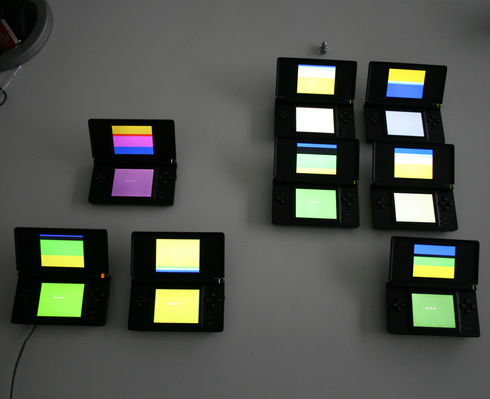chronoPrints
2009
LAb[au], Manuel Abendroth, Jérôme Decock, Els Vermang
Size: 60 x 60 cm and 110 x 110 cm
Technique: pigmentprint on D-bond
format
computer-generated prints with pseudo code
edition of 3
cycle AM or PM (12prints) : edition of 1
Complete cycle (24 prints) : edition of 1
format
as widget , the ChronoApp
as a real-ime illumination of the Dexia Tower, Brussels in 2007
abstract
The plotting of the primary colours of light (red, green, blue) accordingly to the basic units of time (hours, minutes, seconds) creates the chromatic of time.
.
.
transcoding:
transcoding: time to colour
...
text
The artwork is based on an analytic system assigning the basic units of time – hours, minutes and seconds - to the primary colours of light - red, green and blue. This association leads to a process of colour surfaces filling the space over time. This results in overlapping colour surfaces, areas where the secondary colours yellow, cyan and magenta appear.
A chronoPrint is a plot of one hour of a day, starting with its first second at the left upper corner, until the last; 3600th one, at the right bottom corner. Each horizontal line of a print displays the 60 seconds of a minute while the entire 60 lines display the 60 minutes of an hour. Each of the 3600 separated squares is itself divided into solid delineated colour surfaces. The process is based on the ‘American’ 12-hour system dividing a day into two periods (a.m. / p.m.).
This logic finds its expression in the application of a process which involves adding colour between noon and midnight and subtracting colour from midnight to noon. Con- sequently a complete white colour space appears at midnight, when all hours, minutes and seconds have completed, and a complete black colour space appears at noon, when all colours are reduced to zero. This division into two parts is formalised by a white and black background. Accordingly the prints portray a fundamental theme of painting: the relation between colour and time reduced to their most elementary expression.
From this parametric relation emerges colour patterns best described as chromatic textures of time.
TransCoding: the units of time to colour
the artwork also exists as installation of 12 Nintendo DS lite
the artwork also has been displayed on as ChronoTower, Brussels and at Liedts-Meesen Foundation, Gent
history
2009 ___ time|emit, DAM Gallerie, Berlin, Berlin
2009 ___ Young Belgium Painters Award, Bozar, Brussels
2010 ___ From kinetic to digital art, Fondation Vasarely, Aix en Provence
2010 ___ West-Arch, Ludwig Forum, Aachen
2010 ___ Creativity World Biennale, Oklahoma
2011 ___ Tender Buttons, Overpoort, Gent
2013 ___ Poème Numérique, Atomium, Brussels
2014 ___ writing drawing painting, DAM Berlin, Berlin
2014 ___ Accrochage, Denise René rive gauche, Paris
2014 ___ zéro-un _ Galerie Denise René Rive Gauche, Paris
2015 ___ monoChrono, Liedts-Meesen Foundation, Gent,
2016 ___ calculations, permutations, notations, The Major Gallery, London
2016 ___ Langage Codé, La Patinoire, Brussels
2017 ___ Langage Codé, Fontana Gallery, Amsterdam
2019 ___ IF THEN ELSE, Casino Luxembourg, Luxembourg City
2022 / 23 Zeit Zeichen Zeichen Zeit, Kunstmuseum, Heidenheim
2024 ___ painting, writing, calculating, transcoding, Dan Galeria, Sao Paulo


![chronoPrints, LAb[au]](https://static.wixstatic.com/media/fb1d51_8fa7a99746e84e77942acea23993951a~mv2.jpg/v1/fit/w_994,h_460,q_90,enc_avif,quality_auto/fb1d51_8fa7a99746e84e77942acea23993951a~mv2.jpg)
![chronoPrints, LAb[au]](https://static.wixstatic.com/media/fb1d51_5ca7b5bc91434582a265267d8fe93489~mv2.jpg/v1/fit/w_1017,h_460,q_90,enc_avif,quality_auto/fb1d51_5ca7b5bc91434582a265267d8fe93489~mv2.jpg)
![chronoPrints, LAb[au]](https://static.wixstatic.com/media/fb1d51_2ec599c31a3b4cbeaaee61d42a9bdfb6~mv2.jpg/v1/fit/w_490,h_400,q_90,enc_avif,quality_auto/fb1d51_2ec599c31a3b4cbeaaee61d42a9bdfb6~mv2.jpg)
![chronoPrints, LAb[au]](https://static.wixstatic.com/media/fb1d51_84a6c99fcf004bb3aabe84f7299a8847~mv2.jpg/v1/fit/w_490,h_400,q_90,enc_avif,quality_auto/fb1d51_84a6c99fcf004bb3aabe84f7299a8847~mv2.jpg)
![chronoPrints, LAb[au]](https://static.wixstatic.com/media/fb1d51_254e131a335f410c9de961c01321823a~mv2.jpg/v1/fit/w_490,h_400,q_90,enc_avif,quality_auto/fb1d51_254e131a335f410c9de961c01321823a~mv2.jpg)
![chronoPrints, LAb[au]](https://static.wixstatic.com/media/fb1d51_c2b526284a0b497bbc8c042e571d18a6~mv2.jpg/v1/fit/w_490,h_400,q_90,enc_avif,quality_auto/fb1d51_c2b526284a0b497bbc8c042e571d18a6~mv2.jpg)




![chronoPrints, LAb[au]](https://static.wixstatic.com/media/fb1d51_5e4a36b6b89d4ccdaea8a0135f69bda7~mv2.jpg/v1/fit/w_490,h_400,q_90,enc_avif,quality_auto/fb1d51_5e4a36b6b89d4ccdaea8a0135f69bda7~mv2.jpg)
![chronoPrints, LAb[au]](https://static.wixstatic.com/media/fb1d51_5d60f3398a6d4ed8841f11cc34f02619~mv2.jpg/v1/fit/w_490,h_400,q_90,enc_avif,quality_auto/fb1d51_5d60f3398a6d4ed8841f11cc34f02619~mv2.jpg)
![chronoPrints, LAb[au]](https://static.wixstatic.com/media/fb1d51_0a1156edfcf74a3a8a4de403dba28c4f~mv2.jpg/v1/fit/w_490,h_400,q_90,enc_avif,quality_auto/fb1d51_0a1156edfcf74a3a8a4de403dba28c4f~mv2.jpg)
![chronoPrints, LAb[au]](https://static.wixstatic.com/media/fb1d51_8c344a0cb8c94bd3950375d539cefd31~mv2.jpg/v1/fit/w_490,h_400,q_90,enc_avif,quality_auto/fb1d51_8c344a0cb8c94bd3950375d539cefd31~mv2.jpg)